90% of emergency HVAC calls lose momentum before a truck rolls — and those lost minutes cost margins and trust.
I measure success by speed that keeps schedules intact. When I move from an emergency call to a confirmed truck roll in under five minutes, I protect margins and boost customer confidence on every visit.
I treat dispatch as a live, real-time craft, not the same as scheduling. Scheduling lays out availability. Dispatch is how I react when traffic, parts, or urgent jobs change the plan.
My process pairs disciplined intake with a clear dispatch board, GPS, and mobile access for techs. That combo cuts back-and-forth, reduces double-bookings, and gives customers realistic ETAs tied to CRM data.
In this guide I’ll run you through intake to job closeout and share the three rules I use daily. You’ll get short checklists and simple workflows so new staff can make the right calls and keep trucks productive.

Key Takeaways
- Hitting five minutes preserves schedule integrity and margins.
- Dispatch is real-time execution; scheduling is the plan.
- Accurate intake and clear job tags make fast response reliable.
- Lightweight software with GPS and mobile access reduces errors.
- Standardized rules lower mental load and speed new hires.
Why Five-Minute Dispatching Matters for HVAC Today
Every urgent call turns minutes into measurable risk for customer trust and job profitability. I set a five-minute standard because quick confirmation prevents a single breakdown from unraveling an entire day.
Speed reduces wasted drive time and keeps schedules stable. Automation matches jobs to techs in seconds by checking location, availability, and skills. That cuts lag between request and arrival and keeps my plan intact.
Accuracy matters as much as speed. I anchor intake on short checklists and skill-based matching so the first visit succeeds. Fast but sloppy routing only creates repeat trips and worse customer outcomes.
How it changes daily operations
In a busy season, five-minute habits stop cascading delays. My office sees fewer callbacks and fewer overtime hours. Techs spend less windshield time and complete more jobs on schedule.
The business upside is clear: higher close rates on urgent work, stronger SLAs, and a reputation that wins repeat business. Best of all, this is teachable—simple rules and a live board let any company repeat the result.
Field Service Dispatching
A live board and clear rules let me fix the plan before small problems cascade.
I draw a clear line between scheduling and on-the-fly coordination. Scheduling sets tech availability and timelines in advance. Dispatch is the moment-by-moment work that adapts when jobs run long, parts are missing, or emergencies appear.
My dispatcher triages incoming calls, weighs priority against commitments, confirms parts readiness, and matches the right tech without derailing the board. That mix of judgment and rules keeps the office steady on busy days.
I run a tight process: start with a compact schedule, watch a live dashboard, then re-sequence or reroute as techs update status. Automation does skill- and zone-based matching first. I override when context matters—like a tech’s specific expertise or customer relationship.
Clear escalation protocols and quick confirmations cut confusion. When an overrun or emergency hits, I follow a ladder of who to notify and which jobs to shift. The payoff is simple: better management, smoother workflows, and happier customers for businesses that treat these roles separately.
From Call to Truck Roll: The End-to-End Dispatch Workflow
Fast intake and clear tags turn a frantic call into a solvable job in minutes.
I start every job with a compact intake: address, problem description, unit type, urgency, site constraints, and prior history. Capturing that data on the first call prevents wasted trips and missing parts later.
I tag the ticket with a pre-defined job type and checklist so expectations are clear. That tag drives labor, parts, and safety notes and feeds the matching rules I use to route work.
Technician qualification and matching
I match by qualification, not just nearest-available. Certifications, past experience with the equipment, and current workload guide who gets assigned. This approach raises first-time fix rates and reduces repeat visits.
Schedule and dispatch execution
Once matched, I place the job on the schedule and push all details to the technician’s mobile access. Notes, photos, POs, and site info travel with the ticket so the tech has everything on arrival.

Active monitoring and closeout
I watch the live board as techs update status. If traffic or parts shortages appear, I reroute or swap inventory to keep work moving and customers informed.
Before I close a job I require notes, photos, parts used, and time logs. That clean handoff speeds invoicing and feeds data back into my weekly reviews to refine tags, time estimates, and routing rules.
The Three Rules I Use to Dispatch in Under Five Minutes
When minutes matter, I rely on three simple rules that turn chaos into a fast, repeatable process. Each rule trims decisions, reduces back-and-forth, and protects my schedule so techs arrive ready.
Rule One: Standardize intake with a checklist and pre-tagged job types
I hardwire intake with a short checklist that captures address, unit type, urgency, and safety notes. Every ticket gets a prebuilt tag that includes default duration, parts, and a basic estimate.
That tagging cuts gaps in scheduling and makes the job clear before anyone leaves the shop.
Rule Two: Automate skill- and zone-based matching, keep manual override
I use automation to match qualifications and zones so the best tech is picked instantly, not just the nearest one. This boosts first-time fixes and lowers liability in the field.
I still override the system when a tech’s history or truck inventory makes a better fit.
Rule Three: Confirm, notify, and GPS-track—then monitor a live board
I confirm the assignment with the tech, notify customers with an ETA, and turn on GPS so I can watch status in real time. Dispatchers and I use that data to re-sequence the team before small issues become big ones.
These rules cut cycle time, keep management informed, and let my business run a smoother day with fewer surprises.
Automation Wins: How Software Cuts Response Time and Errors
Good software shrinks the gap between a customer call and a confirmed tech on the way.
I rely on automation to match jobs to the right tech using live data on skills, location, and availability. Real-time dashboards centralize open tickets and technician status so I spot problems early.
Real-time dashboards, alerts, and integrated CRM data
I connect my dispatch board to CRM access so site history and notes appear during booking. Alerts flag missed check-ins or overruns, letting me intervene before schedules break.
Route optimization and GPS tracking for accurate ETAs
Route optimization plus GPS tracking gives accurate ETAs and lets me notify customers when traffic or scope changes. That visibility reduces calls and keeps the team aligned.
Automatic status logging for accountability and faster billing
Automatic logs capture arrival times, photos, parts, and notes. Clean documentation speeds invoicing and improves accountability across the field.
Lower overhead by reducing reschedules and double-bookings
I let rules prevent double-bookings by honoring capacity, certifications, and zones. Fewer reschedules mean less wasted time and lower overhead for the business.
Must-Have Features in Service Management Software
Good management software turns a messy calendar into a predictable workday. I expect a platform that gives clear visibility, cuts clicks, and keeps appointments accurate so my team stays focused on work, not paperwork.
Drag-and-drop scheduling with capacity planning
I want a visual board that lets me move jobs in seconds and see capacity at a glance. Drag-and-drop scheduling tools let CSRs rebalance routes when field realities change.
Mobile app for technicians
The mobile app must deliver job info, asset history, photos, and estimates at the job site. When technicians have that access they close more work on the first visit and reduce callbacks.
Service agreements and recurring work
Manage recurring appointments inside the same system so maintenance windows stay protected. Agreement modules prevent repeat scheduling conflicts and protect recurring revenue.
Time tracking, job logs, and fleet visibility
Accurate time logs, photos, and vehicle status feed payroll and job costing. Fleet visibility stops wasted trips by showing which vehicle and equipment are available before I assign a job.
Best Practices I Rely On to Keep the Day on Track
A tight day runs on predictable rules and shared information—without them, small hiccups become full disruptions.
Centralized data is my starting point. I keep customer history, asset notes, and access instructions in one CRM so dispatchers and techs read the same file. That single source cuts back-and-forth and speeds decisions.
Clear escalation protocols
I publish simple thresholds for overruns and emergencies. The protocol lists who to call, reroute options, and timeline windows so the team knows the next move without debating it.
Balance automation with judgment
Automation handles routine matching and scheduling, but I let a dispatcher step in for context—special access, customer relationship, or parts quirks. That combo keeps the board flexible and reliable.
Quarterly reviews and selective tracking
Every quarter I refine tags, zones, and durations based on real results. I also use GPS tracking to validate ETAs and coach routing decisions, not to micromanage. Regular reviews keep operations aligned with peak seasons and staffing changes.
Metrics That Prove You’re Hitting Five Minutes or Less
I rely on a few tight KPIs to prove we meet the five-minute benchmark. Clear numbers stop guesswork and guide where I tune rules, checklists, or board rules. I also use live data to spot trends before customers call.
![]()
Response time, first-time fix rate, technician utilization, and drive time
I measure response time from booking to when the job is dispatched; five minutes is the goal for urgent work. I track first-time fix rate because it shows intake quality, parts readiness, and correct matching.
I watch technician utilization and drive time on the live board to catch routing waste or over-committed schedules. These metrics help me balance jobs and keep the team profitable.
How I use weekly reviews and live boards to course-correct
Each week I review appointments that slipped, missed check-ins, and long pauses. I compare planned versus actual job durations and update tags and capacity rules in our management software.
I use exception alerts to flag unconfirmed visits or overlapping windows. Then I share simple scorecards with dispatchers and technicians so everyone understands targets and actions.
Conclusion
A repeatable playbook beats heroics when every minute matters. I summarize the five-minute formula: standardize intake, automate skill- and zone-based matching with manual override, then confirm, notify, and track on a live board.
When everyone follows a clear system and the software ties booking, mobile workflows, and invoicing, speed comes from clarity—not chaos. Integrated platforms like FieldAx show how end-to-end solutions help teams run predictable operations and protect margins.
The result is better customer experience and improved customer satisfaction: quick confirmations, accurate ETAs, and smooth handoffs to billing. Run weekly reviews and quarterly rule updates so your office adapts to location, season, and staffing changes.
I encourage you to adopt the checklist-driven process and the metrics I shared. With that discipline, fast, reliable jobs become the daily norm across your business and across multiple businesses and locations.
See how FieldAx can transform your Field Operations.
Try it today! Book Demo
You are one click away from your customized FieldAx Demo!
FAQ
What exactly do you mean by “five-minute dispatching” for HVAC?
I mean getting a usable, assigned job from the first emergency call into a technician’s route within five minutes. That includes intake, triage, tech matching, customer confirmation, and a live update to the schedule so the team can move immediately.
How do I capture accurate information on the first call without slowing things down?
I use a short checklist of required fields—problem type, severity, access instructions, and any safety notes—plus pre-tagged job types that auto-fill common steps. This keeps calls fast while delivering the data the dispatcher and technician need.
How does skill-based routing improve outcomes compared with nearest-available?
I prioritize technicians who have the right certification and parts knowledge first. Nearest-available can get a truck on scene faster, but a skill mismatch leads to repeat trips. Matching by skill raises first-time fix rates and reduces drive time overall.
What role does mobile access play in the workflow?
Mobile apps let technicians receive job details, upload photos, update status, and capture customer signatures on-site. I rely on that instant communication to adjust routes, confirm ETA, and speed invoicing through automatic time logs.
How do I keep customers informed without adding work for dispatchers?
I set up automated notifications tied to dispatch events—confirmation, ETA updates, and arrival notices. That reduces incoming calls and lets dispatchers focus on complex problems while customers get timely updates.
What automation features have the biggest impact on response time?
I find real-time dashboards, automatic skill-and-zone matching, route optimization, and status logging deliver the biggest gains. They cut manual lookups, reduce reschedules, and keep the dispatcher’s live board accurate.
Can automation be overridden when a human judgment call is needed?
Absolutely. I always keep a manual override so dispatchers can reassign a job for customer preference, parts constraints, or safety reasons. The best systems combine rules with easy manual control.
Which metrics should I track to prove my five-minute goal?
I track response time to dispatch, first-time fix rate, technician utilization, and drive time. Weekly reviews of those KPIs on a live board make it clear where to tweak rules or capacity.
What must-have features should I check for when choosing management software?
I look for drag-and-drop scheduling, capacity planning, a robust mobile app, service agreement management, time-tracking, and fleet visibility. Those features reduce overhead and support consistent, fast turnarounds.
How do I handle parts shortages or unexpected reroutes during a job?
I use active monitoring and integrated parts inventory so reroutes happen quickly. Dispatchers get alerts, can reassign technicians with the right parts, or schedule a follow-up while communicating updates to the customer.
How often should I review and refine dispatch rules?
I recommend quarterly reviews and immediate after-action checks following major incidents. Regular tuning keeps routing and prioritization aligned with changing demand, technician skills, and seasonal peaks.
Can small companies realistically adopt five-minute dispatching?
Yes. I often start small: standardized intake, one or two automation rules, and a simple mobile tool. Those changes alone cut calls and speed assignment. You scale automation and features as your team grows.
How do I ensure accurate billing after rapid dispatch and closeout?
I enforce structured closeout: standardized notes, mandatory photos when required, automatic time logs, and parts capture. That creates a clean handoff to invoicing and reduces disputes or missing charges.
Author Bio
Co-Founder & CMO at Merfantz Technologies Pvt Ltd | Marketing Manager for FieldAx Field Service Software | Salesforce All-Star Ranger and Community Contributor | Salesforce Content Creation for Knowledge Sharing






